Mrs C has given me a very interesting textile on long term loan, and I thought it would be the perfect ‘Textiles on Thursday’ feature.
The textile is an embroidered silk coat with a rabbit fur lining.
The coat is fascinating for all sorts of reasons. It’s an excellent example of an export textile, made in Asia (probably China, possibly Japan) for the Western market. As an export textile, it’s particularly interesting because it isn’t a particularly luxurious item. Chinese design features aside, the coat is a great piece of early 1920s fashion. Finally, it’s an exciting vintage item because it isn’t that small, it easily fits a modern 14-16. Poor Isabelle is a little swamped in it!
So, let’s break it down. First, what’s this export textile thing?
Well, the West has had a love affair with Eastern goods and aesthetics for centuries. Just look at Chinoiserie in the 18th century and Japonism in the 19th century, as well as the trade in kashmir shawls in both.
The newest trends in Eastern imports always began as luxury goods, but as demand increased the makers developed less expensive ways to produce their goods, and cheaper imitations of the original good (e.g. wool and silk kashmir shawls rather than cashmere kashmir shawls)
This jacket is a 20th century example of a style that began as a luxury good, but became cheaper over time. The jacket still looks posh to modern eyes: after all, it is hand embroidered silk lined in fur, but a closer inspection reveals its more affordable origins.
First, the jacket is lined in rabbit fur, which has always been the cheapest and least luxurious fur.
The fur is also rather cheaply and inexpertly joined: the individual squares of fur are clearly visible in the lining.
Over time the fur lining has dried out, and is beginning to shed white fur. Sadly, as far as I know, this process is irreversible.
The cut of the coat is also less than expert: the silk outer was never strong enough to support the heavy fur lining, and no additional support was provided in the neck and shoulders to hang the fur from, so the silk in this area has shattered and unravelled under the stress.
The other telling clue about the original value of the jacket is the embroidery. High quality examples of jackets like these would have had silk embroidery worked specifically for the jacket by expert embroiderers who worked without a pattern. The embroidery on this jacket, however, was worked over a simple transfer pattern, resulting in much blockier, less elegantly flowing patterns.
The transfer pattern is still visible beneath the stitching, and in some places it has been left to visually fill in the pattern, saving on stitching time.
Other construction and finishing elements are not quite perfect: the bias borders are stitched on with large, visible stitches, and don’t perfectly frame the embroidered images. Black thread is used to sew on white silk, and white to sew on black.
While a Western demand for cheaper goods is partly responsible for the decline in workmanship and taste, it was not the only culprit. The 19th century saw a huge decline in China’s status and power, which was mirrored by a decline in workmanship and artistic standards. By the 1910s and 20s China literally ‘just didn’t make things like they used to’.
Along with the decline in workmanship and artistic standards came a decline in the importance of symbolism. The colours and motifs chosen for the embroidery were based on Western demands and traditions that the workers no longer understood or cared about, leading to a muddling of the aesthetic.
Take the moths that surround the embroidered roundels that ornament the jacket. In Chinese symbolism moths and peonies represent the attraction and relationship between men and women. The male moth is drawn the the beauty of the female peony, and the peony depends on the moth to spread her pollen. In the embroidery on the coat, the traditional peony has been replaced by a chrysanthemum, either out of ignorance or in accordance to Western taste.
Despite the absence of traditions, the embroidery on the body of the coat still has traces of the elegantly serpentine lines that made Chinese embroidery famous in the West. The moths in particular, are gorgeously evocative of their spirit.
Ironically, the better quality embroidery on the body of the coat is actually another sign of the decline in quality of Chinese goods: the coat components were probably embroidered in separate workshops as relatively ‘mass produced’ components, not specifically intended for this garment.
Despite the decline in quality, the coat still has many very interesting and thought out design features. The wide panel of embroidery at the cuff of the sleeve, for example, doesn’t go all the way around the sleeve. The innermost portion of the panel is plain patterned fabric. At first this seems like a mistake, or a product of the mass produced components (e.g. the embroidery was the wrong length), but what is really happening is that the designer has cleverly not put embroidery where it will get the most wear, and could catch on the body of the coat. You see the exact same same thing happening with the lace on the cuffs of Suson’s jacket in Manet’s A Bar at the Folies-Bergère.
With all this talking about the poor-quality embroidery and shoddy workmanship in this jacket, I’m afraid you might be thinking that I’m turning up my nose at it. Far from it!
Even though the craftmanship on this jacket is not a patch on earlier Chinese export embroidery, it is still a marvel of needlework, and time, and dedication.
And the fact that it wasn’t the best quality of export actually makes it even more interesting. For a long time most museums only tried to collect the very ‘best’ examples. And the wealthier the original buyer, the less the probably wore the garment, and the higher the likelyhood that they would store and keep it, or donate it to a museum, once they were tired of it. So these days there isn’t a lot of ‘low quality’ Asian for the Western market goods around, making this one a rarity.
Also, I’m just a sucker for ordinary peoples stories. We have no idea who bought this jacket, and wore it, and loved it, but there is a good chance that (even though it was a less expensive import item) the purchase represented a huge expenditure to the buyer. She would have loved and cherished this jacket, and felt like the most gorgeous, exotic thing in the world when she wore it. A coat like this would mean a lot more to a woman of ordinary means than to a wealthy society woman who bought new coats every season. And that means a lot more to me.
Thank you so much dearest Mrs C for making this available to me to drool over and blog about!

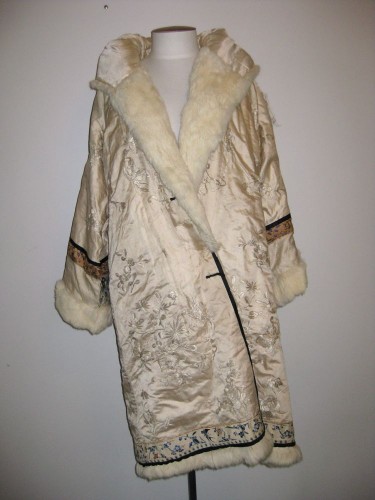
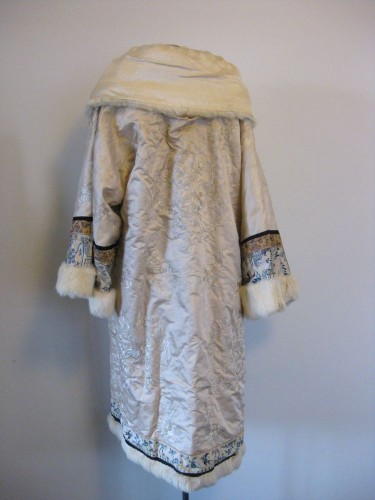
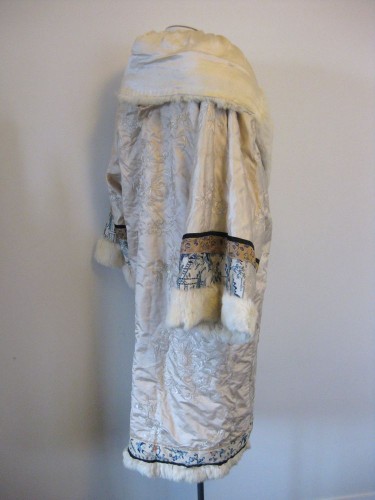
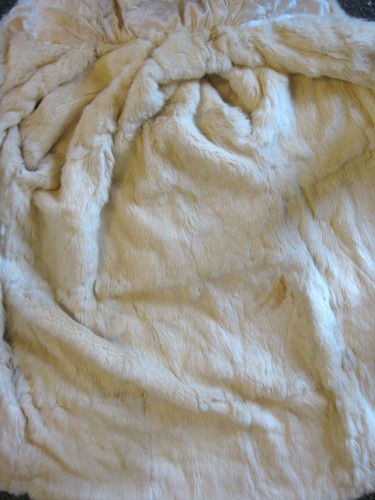
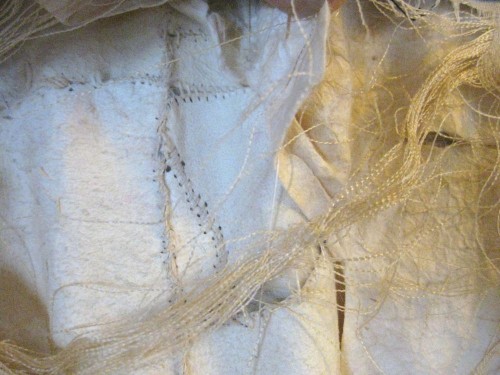
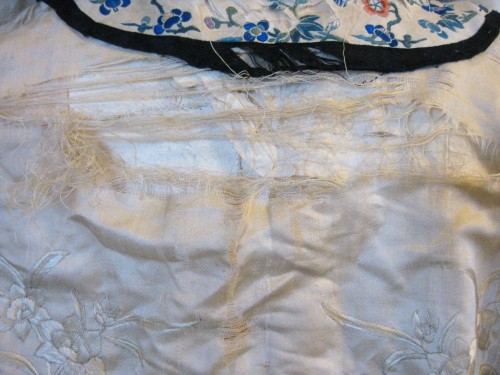

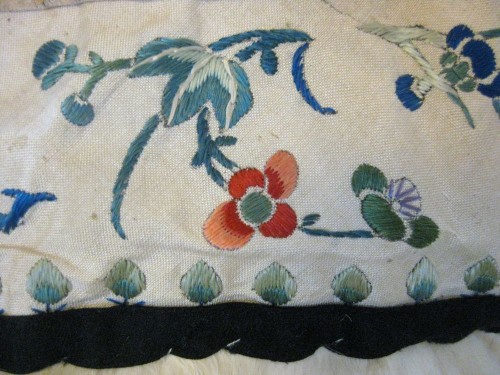
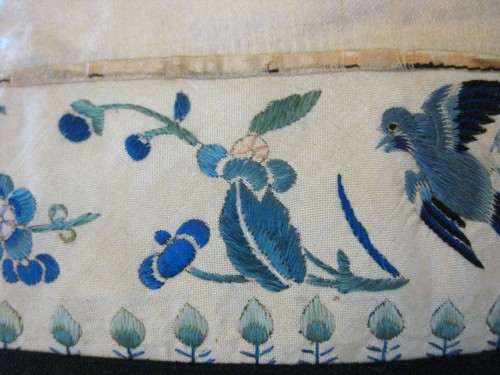
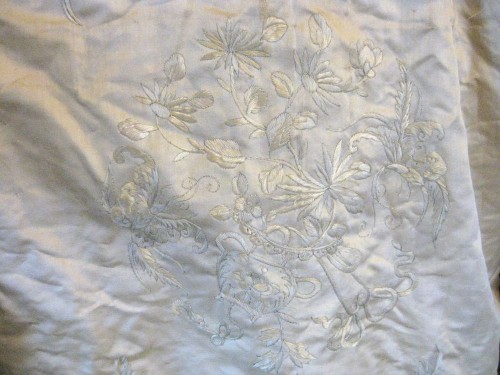


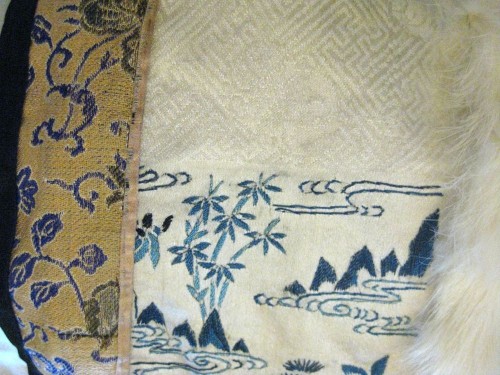
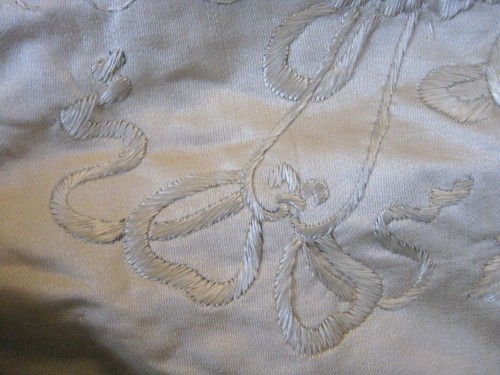
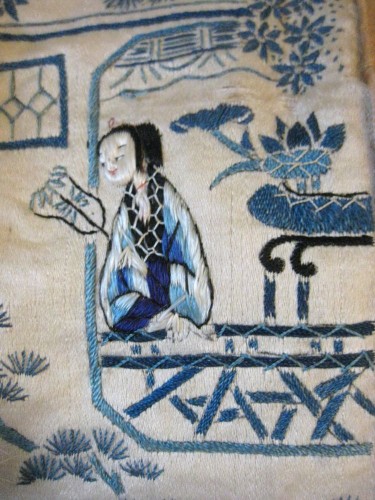
Dang, I was just at the Galleria del Costume in Florence and I saw a very similar coat. The shell was black though, and it was Italian in provenance so the embroidery was more Western. It was definitely from the twenties, though. It was in a case full of very extravagant furs, so I wasn’t paying much attention to it… but I’m sure it was there! I can’t find a picture of it for the life of me, though.
Very pretty!
I also suspect that Anna, who has owned this for decades, has always worn it fur out, so the silk in the shoulders would have been exposed to body heat etc a lot more, accelerating its deterioration. I shall endeavour to find out more about its life history, she is a pretty darn interesting lady! And I suspect it was her mother’s, but not sure. She is a friend of the Embroidenator which is always a good start in the interesting story dept 😉
I adore this coat. I haves the massive envy for the precious. Chinese and Japanese embroidery is interesting and beautiful to my eye. Peonies are my favourite flowers. Soft delicious cram bunny Fur squeee!! Ah sigh it is lovely…I don’t care if it was cheaper it’s divine.